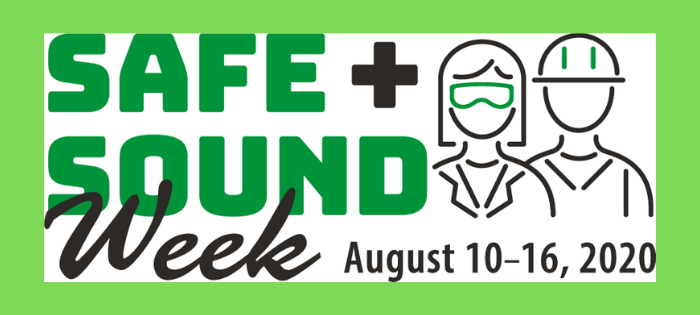
Safety
Comments: No Comments
According to the U.S. Bureau of Labor Statistics, more than 5,000 workers are killed on the job every year (a rate of 14 per day), and more than 3.6 million experience a serious job-related injury or illness.
OSHA’s Safe + Sound Week
Strong safety performance is a cornerstone of any business. Safe facilities, work practices, and training help to attract and retain employees and enable them to go home at the end of the shift without workplace injury or concerns.
For many companies, safety can also make the difference in being qualified to work with customers and successfully expand the business. Workers’ compensation rates and the ability to maintain adequate insurance both depend on an organization’s safety performance. On the other end of the spectrum, repeated safety accidents can lead to potential serious penalties and higher insurance rates for failing to comply with OSHA safety requirements.
Every year, OSHA encourages America’s workplaces to commit to workplace safety and health by participating in Safe + Sound Week, which falls August 10-16, 2020. This nationwide event recognizes the successes of workplace safety and health programs and offers information and ideas on how to keep America’s workers safe.
The Importance of Safety Programs
According to OSHA, implementing safety programs can improve businesses’ safety and health performance, save money, and improve competitiveness. Safety and health programs help businesses:
- Prevent workplace injuries and illnesses
- Improve compliance with laws and regulations
- Reduce costs, including significant reductions in workers’ compensation premiums
- Engage workers
- Enhance social responsibility goals
- Increase productivity and enhance overall business operations
Keeping Your Programs in Check
It is important for companies to regularly assess the level of existing OSHA programs against compliance issues and potential accidents. This requires both short- and longer-term actions. These actions should reveal what may need to change in your OSHA compliance programs to ensure their effectiveness. There will likely be a range of results depending on how well the initial programs were developed, implemented, and updated.
KTL recommends taking the following actions to help assess and improve OSHA programs, as needed:
- Develop a review plan. Schedule a meeting with key management and safety and health staff to develop a plan to review all OSHA programs for compliance to the standard. It is not uncommon for internal audits and insurance company audits to be based on confirmation of a compliance policy and not the level of detail required in the implementation of the policy. In the meeting, a complete review of programs should be delegated, including a review of the OSHA standards themselves. This should be based on criteria, including the level of detail, training, and updates and supporting logs/records.
- Review internal and loss prevention reports. This review should consist of the last three years of internal and loss prevention reports, including local fire. The findings of these should be compared against review findings to verify that necessary changes have been implemented.
- Review OSHA reporting and recordkeeping. Again, review should be based on the past three years of historical records. Not only should these records be verified as accurate and complete, but each accident should have resulted in either a documented corrective action of an unsafe situation or the retraining of an employee. This information should be checked, and any additional actions should be made to fully comply.
- Ensure proper closure of issues. Should you have had any past OSHA inspections at your facility(ies) that identified corrective actions, you need to ensure that proper actions were taken to close these issues. Again, it is very important to verify and assemble all related records.
- Conduct multiple physical walkthroughs for all work, personal, and administrative areas for compliance. Update or create a safety inspection checklist for each section, area, and department to confirm that there are no violations in manufacturing, lab, and/or office/administrative areas. Note that one area often missed is the adequate spacing and egress from office cubicles and file rooms.
- Document corrective actions. Your review should help to determine the corrective actions required for your programs to fully comply with OSHA standards and keep employees safe. These corrective actions should result in safety program updates that should be implemented immediately. Any updates need to be announced and included in employee training, which will also need to be scheduled and documented.
- Evaluate results. Concurrently, a qualified safety professional should compare the review findings, your accident statistics, and the top OSHA violations. If there are common links to programs, statistics, and OSHA violations report, an added level of scrutiny should be placed on this area and the resulting program updates.
- Meet requirements. Ensure that all the basic requirements are met and that the company is operating in compliance, including accident/injury records, training records, inspection logs, and a log for all program updates implemented.
Inspection Readiness
When the actions outlined above are done correctly—and on a regular basis—companies can greatly reduce their risk for compliance issues and create a safer work environment for employees. To fully verify safety program changes, a confirming review or audit should be completed within a 30-45-day strict timeframe, and any additional changes or training should be completed immediately. This will also put the company in a much better position for an OSHA inspection should it be required.
Throughout this process, owners and managers need to focus on prevention and on the overall culture of the company in terms of taking the necessary steps to reduce risk and make prevention part of daily operations. Good practice is to examine the workplace broadly, identify and assess hazards, and develop and implement appropriate controls. This helps ensure employees are protected in the workplace and regulatory compliance is achieved.
